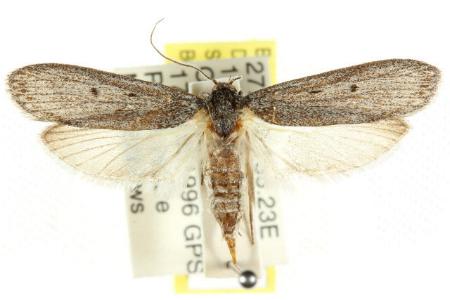
| CHEZALA GROUP OECOPHORINAE, OECOPHORIDAE, GELECHIOIDEA | (donherbisonevans@yahoo.com) and Stella Crossley |

(Photo: courtesy of CSIRO/BIO Photography Group,
Centre for Biodiversity Genomics,
University of Guelph)

| CHEZALA GROUP OECOPHORINAE, OECOPHORIDAE, GELECHIOIDEA | (donherbisonevans@yahoo.com) and Stella Crossley |

(Photo: courtesy of CSIRO/BIO Photography Group,
Centre for Biodiversity Genomics,
University of Guelph)
These Caterpillars appear to live in the nests of some tree-hole nesting parrots, such as
The caterpillars feed on the droppings of the nestlings, thus keeping the nest clean.
The adult moths have grey or brown forewings, each with one or two dark spots near the middle. The hindwings are white each shading darker at the apex. The wingspan is about 2.5 cms.
The moths are very similar to those of the related species Trisyntopa scatophaga and Trisyntopa neossophila, but have paler and narrower wings.
The species Trisyntopa euryspoda has been found in
Further reading :
Ian F.B. Common,
Moths of Australia,
Melbourne University Press, 1990, fig. 22.12, p. 225.
Ian F.B. Common,
Oecophorine Genera of Australia III:
The Barea Group and Unplaced Genera (Lepidoptera: Oecophoridae),
Monographs on Australian Lepidoptera Volume 8,
CSIRO Publishing (2000), pp. 17-18, 360-366.
Oswald B. Lower,
New Australian Lepidoptera with synomic notes - No. XXIV,
Transactions of the Royal Society of South Australia,
Volume 42 (1918), pp. 238-239.
Penny Olsen,
Glimpses of Paradise: The Quest for the Beautiful Parrakeet,
National Library of Australia, 2007.
 caterpillar |  butterflies |  Lepidoptera |  moths |  caterpillar |
(written 14 October 2013, updated 1 October 2025)